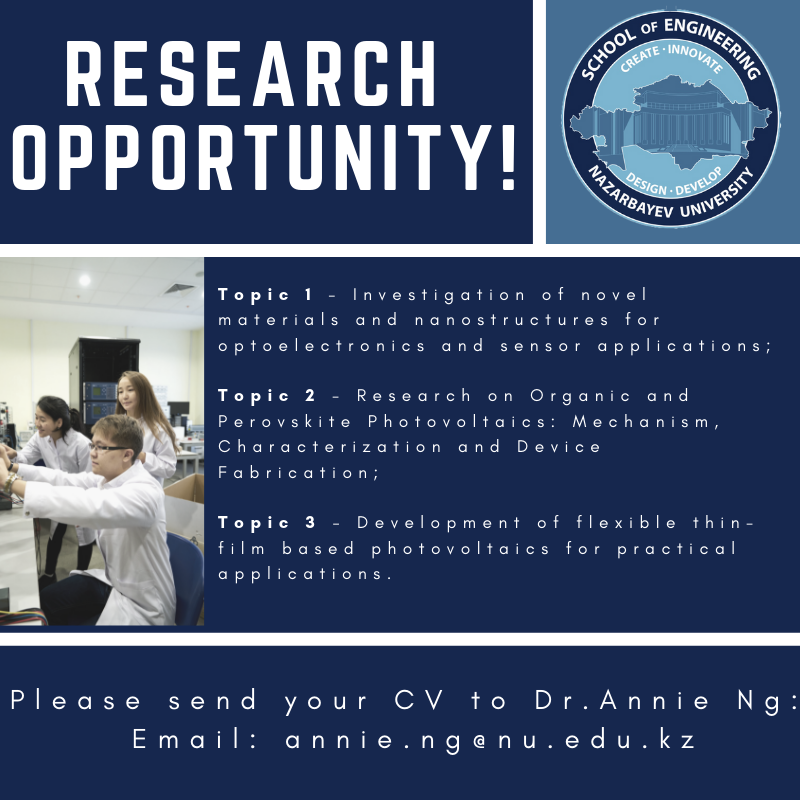Research opportunity for students!

Prof. Annie Ng (ECE) is glad to invite Master and PhD students to take part in the Research project on following topics:
Topic 1 Investigation of novel materials and nanostructures for optoelectronics and sensor applications
A diversity of new materials and nanostructures have emerged in research fields. The unique properties of these materials result in significant breakthroughs in technologies of electronics in terms of efficiency, sensitivity, resolution, bandwidth, operation speed, energy consumption, compactness, size, production cost and other new functionalities. This project aims to explore novel materials and develop new technologies for fabricating high-functional optoelectronic devices and sensors. Students will look into the emerging materials for various electronic devices such as 2- D materials including graphene, black phosphorus and transition metal dichalcogenides; perovskite materials including inorganic perovskites and organometal halide perovskites; and other promising organic materials. This project will also include research of wide bandgap nanostructured materials such as ZnO, TiO2, SnO2, WO3, In2O3, NiO, Ga2O3 etc. Students will synthesize different nanostructures and investigate their properties by a series of state-of-the-art techniques (e.g. SEM, TEM, AFM, XRD and different spectrometers etc.). The optimized materials will be applied in optoelectronic devices (e.g. solar cells, LED etc.) or different kinds of sensors (e.g. biosensors, gas sensors, light sensors etc.). The ultimate goal of this project is to accelerate the innovation of electronic technologies, leading to revolution of lifestyles in the 21st century.
(1) K. K. Wong, A. Ng, X. Y. Chen, Y. H. Ng, Y. H. Leung, K. H. Ho, A. B. Djurišić, A. M. C. Ng, W. K. Chan, L. Yu, D. L. Phillips, “Effect of ZnO Nanoparticle properties on dye-sensitized solar cell performance,” ACS Appl. Mater. Interfaces 4, 1254, 2012. (2) A. Ng, W. K. Yiu, Y. Foo, Q. Shen, A. Bejaoui, Y. Zhao, H. C. Gokkaya, A. B. Djurišić, J. A. Zapien, W. K. Chan, C. Surya, “Enhanced performance of PTB7:PC71BM solar cell via different morphologies of gold nanoparticles,” ACS Appl. Mater. Interfaces, 6, 20676, 2014. (3) C. Liu, R. Zhu, A. Ng, Z. Ren, S. H. Cheung, L. Du, S. K. So, J. A. Zapien, A. B. Djurišić, D. L. Phillips, C. Surya, “Investigation of high performance TiO2 nanorod array perovskite solar cells,” J. Mater. Chem. A, 5, 15970, 2017.
Topic 2 Research on Organic and Perovskite Photovoltaics: Mechanism, Characterization and Device Fabrication
Solar energy is one of the abundant and easy accessible energy sources. Comparing to other renewable energies such as wind power, hydropower and geothermal energy, solar energy is relatively less limited by the geographical factors of the environment. With the adequate energy harvesting devices i.e. solar cells, the energy of light can be converted into the useful electrical energy. Nowadays, the photovoltaic industry is still optimizing the solar technologies in order to develop solar cells with high performance, novel properties (lightweight, flexible, transparent) as well as low production costs. This project requires students to do research on the new generation thin-film solar cells (organic or perovskite solar cells). Students will work in laboratories and have hands-on experience in material growth and device fabrication. They also need to use modern characterization techniques to investigate the properties of materials and devices. Based on the literature and experimental results, students need to find out effective strategies to solve one or multiple problems in the research field of thin-film solar cells and propose the underlying mechanisms. This project not only
enhances the students’ knowledge in research but also develops their critical thinking, analytical and problem-solving skills throughout the training period, which equip them for future success in the research and career.
(1) A. Ng, Z. Ren, Q. Shen, S. H. Cheung, H. C. Gokkaya, G. Bai , J. Wang, L. Yang, S. K. So, A. B. Djurišić, W. W. Leung, J. Hao, W. K. Chan, C. Surya, “Efficiency enhancement by defect engineering in perovskite photovoltaic cells prepared using evaporated PbI2/CH3NH3I multilayers,” J. Mater. Chem. A, 3, 9223, 2015. (2) A. Ng, Z. W. Ren, Q. Shen, S. H. Cheung, S. K. So, A. B. Djurišić, Y. Y. Wan, X. J. Wu, C. Surya “Crystal engineering for high efficiency perovskite solar cells by hybrid chemical vapor deposition growth technique,” ACS Appl. Mater. Interfaces 8, 32805, 2016 (3) A. B. Djurišić, F. Z. Liu, H. W. Tam, M. K. Wong, A. Ng, C. Surya, W.Chen, Z. B. He, “Perovskite solar cells – An overview of critical issues,” Prog. Quantum Electron. 53, 1, 2017.
Topic 3 Development of flexible thin-film based photovoltaics for practical applications
The solar technology is of significant importance to support the sustainable development in the 21st century as it is easy to be infiltrated into our everyday life through the installation of solar cells/panels onto the buildings, transportations or electronics etc., which introduce us revolutionary changes in utilizing the clean, safe and renewable energy. The organic solar cells and perovskite solar cells are the emerging photovoltaics with the record power conversion efficiency of 11.5 % and 22.7% respectively. In contrast to the market-dominant crystalline silicon solar cells, organic solar cells and perovskite solar cells have their advantages such as lower manufacturing costs, lightweight, transparent and high flexibility, which open up many opportunities for novel applications (e.g solar windows, portable solar chargers and wearable solar cells). In this project, students need to fabricate the device based on flexible substrates and solve the existing problems such as device stability and film uniformity for realizing practical applications of organic/perovskite solar cells with selection of appropriate materials, optimization of material deposition techniques, development of effective encapsulation strategies and design of efficient modules. Finally, students should demonstrate the potential applications of their developed flexible solar cells in any aspect.
(1) A. B. Djurišić, F. Liu, A. M. C. Ng, Q. Dong, M. K. Wong, A. Ng, C. Surya,
“Stability issues of the next generation solar cells,” Phys. Status Solidi RRL, 10, 281, 2016. (2) H. Jinno, K. Fukuda, X. Xu, S. Park, Y. Suzuki, M. Koizumi, T. Yokota, I. Osaka,
- Takimiya, T. Someya, “Stretchable and waterproof elastomer-coated organic photovoltaics for washable electronic textile applications,” Nat. Energy, 2, 780, 2017. (3) L. Qiu, L. K. Ono, Y. Qi, “Advances and challenges to the commercialization of organic–inorganic halide perovskite solar cell technology” Mater. Today Energy, 7, 169, 2018.
Students involved in all research projects above will work closely with experienced researchers in National Laboratory Astana, Optoelectronic and Nanomaterials Laboratory in The University of Hong Kong and Microfabrication Laboratory in The Hong Kong Polytechnic University. The projects mentioned above require theoretical studies and experimental investigations. Students who have strong interests in the field of optoelectronics, sensors and related devices with high level of self-disciplined, motivated, and patient attitudes are very welcome to join us.
Please send your CV to Prof. Annie Ng (Email: annie.ng@nu.edu.kz)



